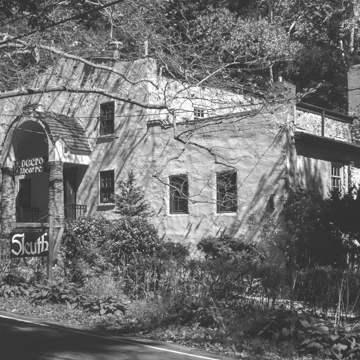To an existing c. 1840 grain mill, Price added the front portico of reinforced concrete and red tile with rubble stone columns, like those of the barn adapted for the Stephens house, and adapted the mill floor to a studio/meeting room/theater for his community. When the Rose Valley Corporation closed, the Guild Hall was acquired in 1923 by Jasper Deeter, whose work with the Provincetown Players, among them Eugene O’Neill and Edna St. Vincent Millay, led him to try a residential repertory theater. Wharton Esherick (see CH38) worked with the theater in its early years, designing furniture for the lobby. The theater was rebuilt after a disastrous fire that destroyed much of the main hall, and thrives today. Fortunately, the Wharton Esherick table and chairs made of axe handles survived the conflagration. The repairs to the exterior substituted modern gray Portland cement for the original warm earth-toned rough cast stucco of the Price era.
You are here
Hedgerow Theater
c. 1840; 1903 altered, William L. Price; c. 1985, Richard C. Meyer. Rose Valley Rd. above Possum Hollow Rd.
If SAH Archipedia has been useful to you, please consider supporting it.
SAH Archipedia tells the story of the United States through its buildings, landscapes, and cities. This freely available resource empowers the public with authoritative knowledge that deepens their understanding and appreciation of the built environment. But the Society of Architectural Historians, which created SAH Archipedia with University of Virginia Press, needs your support to maintain the high-caliber research, writing, photography, cartography, editing, design, and programming that make SAH Archipedia a trusted online resource available to all who value the history of place, heritage tourism, and learning.













